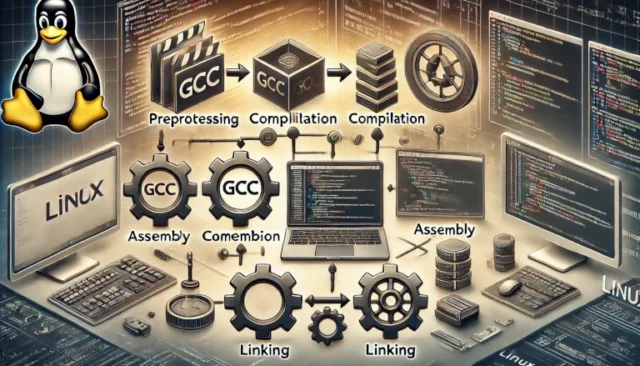The GNU Compiler Collection (GCC) is a powerful and versatile tool used to compile and build programs in various programming languages. Understanding the steps involved in GCC compilation can help developers debug issues, optimize code, and gain insight into how their source code is transformed into an executable program. This guide explores the key steps in the GCC compilation process and provides actionable insights for Linux developers.
What is GCC?
GCC is a free and open-source compiler system designed for multiple programming languages, including C, C++, and Fortran. It’s the de facto standard for compiling software on Linux platforms, enabling developers to convert human-readable source code into machine-readable binary files.
Overview of GCC Compilation Process
The GCC compilation process can be broken down into four key steps:
- Preprocessing
- Compilation
- Assembly
- Linking
Each of these steps performs a specific role in converting the source code into an executable file. Let’s dive into each phase.
1. Preprocessing
The preprocessing stage processes the source code for directives, such as #include and #define. The preprocessor handles the inclusion of header files, macro expansions, and conditional compilation.
To generate the preprocessed output, use the -E flag with the gcc command:
gcc -E source.c -o source.iHere:
source.cis the input source file.source.iis the preprocessed output file.
The resulting .i file is a plain text file containing the expanded source code.
2. Compilation
In this stage, the preprocessed code is translated into an intermediate representation known as assembly language. The compiler checks the syntax, semantics, and type correctness of the code and performs optimizations.
To generate the assembly code, use the -S flag:
gcc -S source.i -o source.sHere:
source.scontains the assembly code.
3. Assembly
The assembly stage converts the assembly language code into machine code, resulting in an object file. The assembler performs this task.
To generate the object file, use the -c flag:
gcc -c source.s -o source.oHere:
source.ois the object file, which contains machine code but is not yet executable.
4. Linking
Linking combines the object file with necessary libraries and resolves function and variable references. This step produces the final executable.
To create the executable file, use the following command:
gcc source.o -o executableHere:
executableis the final program that can be run on the system.
Putting It All Together
You can perform all the steps in one command to directly generate the executable:
gcc source.c -o executableThis command runs through all the stages seamlessly, producing the final executable file.
Common Issues and Their Solutions
1. Missing Header Files
Errors like fatal error: <header_file>: No such file or directory occur when GCC cannot find the required header files.
Solution:
- Install the necessary development packages using your package manager.
- Specify include paths with the
-Ioption:
gcc -I/path/to/headers source.c -o executable2. Undefined References During Linking
Errors such as undefined reference to ‘<function>’ occur when a library is not linked correctly.
Solution:
- Use the
-lflag to link the required library:
gcc source.c -o executable -lmHere, -lm links the math library.
3. Debugging Compilation Errors
Syntax or semantic errors may halt the compilation process.
Solution:
- Enable verbose error messages with the
-Wallflag:
gcc -Wall source.c -o executableAdvanced Compilation Techniques
Optimizations
Enable optimizations to improve runtime performance or reduce binary size:
- Optimize for speed:
gcc -O2 source.c -o executable- Optimize for size:
gcc -Os source.c -o executableDebugging Symbols
Include debugging symbols in your executable for use with tools like gdb:
gcc -g source.c -o executableConclusion
Understanding the GCC compilation process equips developers with the tools to write, compile, and debug code more effectively. By breaking down the compilation steps—preprocessing, compilation, assembly, and linking—you can isolate errors, optimize performance, and gain a deeper understanding of how your code transforms into an executable program.

1 thought on “Understanding GCC Compilation Steps in Linux”